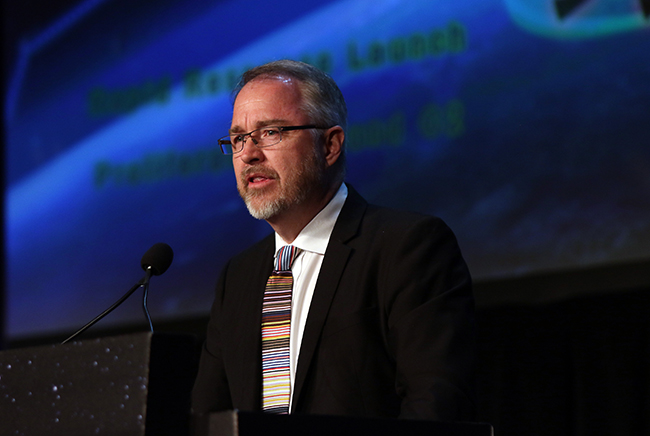
Fred Kennedy, the first director of the new Space Development Agency, addresses a crowd at the Space Foundation's Space Symposium on April 9, 2019, in Colorado Springs, Colo. Space Foundation photo.
COLORADO SPRINGS, Colo.—The newly established Space Development Agency promises to chart the first steps of a “comprehensive architecture” to address eight critical defense priorities by the end of September, the organization’s director said here Tuesday.
Fred Kennedy, who comes to the fledgling SDA from the Defense Advanced Research Projects Agency, aims to present a fuller picture of what that architecture should look like to Pentagon leadership by the end of the fiscal year. If all goes well, the SDA would develop, buy, and deploy its first assets on orbit, along with ground segments, no later than 2022.
“Anyone who’s tasked to plan or fight a future war with a peer competitor will need perishable data on demand, at scale, around the globe because our adversaries are cutting deeply into our decision timelines and we don’t have a choice, we have to respond,” he said at the Space Foundation’s Space Symposium.
Some of the ideas the SDA is tasked with tackling, include:
-
Defending against advanced missile threats
-
Deploying alternative navigation capabilities that could stand in if GPS satellites are harmed
-
Creating a consolidated, autonomous battle management system
-
Wielding artificial intelligence to manage an Internet of military things
-
Growing industry’s ability to quickly launch small and medium payloads when assets need to be upgraded or replaced.
Its aims are larger than the layer of sensors in low Earth orbit that will be its first project.
“The SDA and its partners, particularly DARPA, its Blackjack program … will work with companies building mass-produced, small spacecraft, ground command-and-control systems ‘in a box,’ commercial launch services, and low-cost user terminals,” Kennedy said. “I’m talking about radios, phased array antennas … on a ship, a Humvee, tactical aircraft, a munition, [a] soldier’s phone.”
While the Pentagon now mostly focuses its attention between the Earth and geosynchronous Earth orbit, 22,200 miles above the planet, Kennedy argues more eyes need to watch the space between GEO and lunar orbit. He’d like to see a network that can watch where everything is moving in space in real time, with the ability to respond in case of trouble.
To do so, Kennedy hopes to piece together a network of hundreds or thousands of satellites used for deterrence, missile tracking, communications transport, and tracking military assets. He also discussed “advanced maneuvering vehicles,” notional platforms that would let the military head off threatening adversaries traveling through space.
“We envision a validation exercise, or exercises, as early as 2022 with combatant command and intelligence community partners to demonstrate what we’ve learned and how we will move forward,” Kennedy told reporters Tuesday. “We will work with the services and other stakeholders to move this architecture.”
Once SDA begins proving whether the concept can work in the next four years, Kennedy wants to start rolling out new capabilities in two-year cycles. The agency will also explore ways to collaborate with companies launching communications payloads into low Earth orbit in the early 2020s as well.
“There’s no one way to get this job done,” Kennedy said. “We have to look at this from the perspective of a balanced portfolio for national security space and we should not jump to extremes, whether that’s protect and defend or proliferate.”
To get started, Kennedy expects to release a request for information so industry can weigh in on whether SDA’s plans are feasible. A formal solicitation would follow by the end of September.
As the initial work gets underway, SDA will also be preparing to join the Space Force within two years if Congress approves it as part of the fiscal 2020 defense policy bill. Details of how Kennedy, who has the authority to develop and buy the parts of this future architecture, will work with the services’ acquisition branches are still murky.
Kennedy told reporters he expects his work will drive changes to established Air Force programs like Next-Generation Overhead Persistent Infrared and GPS IIIF. But the service shouldn’t stop planning, he added.
“This is early days, but I believe that there will be a long conversation regarding how the SDA, the Air Force, other services, and even the Intelligence Community, work together to produce a space architecture,” he said. “At this moment, I can’t tell you what elements of Air Force architecture will be extant in 2030. But what I will say is, if we get out five or six years from now and it’s apparent that some of the things we’re doing with proliferated LEO are making sense, and the capabilities are very interesting and very useful, … some things will have to stand down.”
At a roundtable with reporters Wednesday, Air Force Secretary Heather Wilson reiterated that there is no one-size-fits-all solution to addressing space threats and that next-generation space systems are funded in the 2020 budget. She did not offer specifics about how the service will ensure its development and procurement plans stay in lockstep with SDA.
Could an Air Force space architect be one answer to ensure the Defense Department is making smart investments? Will Roper, the service’s acquisition executive, said he hasn’t thought through the idea. Once the Air Force proves an architect can pull together a new Advanced Battle Management System, he said, then they’ll think about what comes next.
“Space is an area that you could see there being a role for that,” he told reporters Wednesday. “My instinct right now is, try to get the lessons learned from the Advanced Battle Management architect out.”
